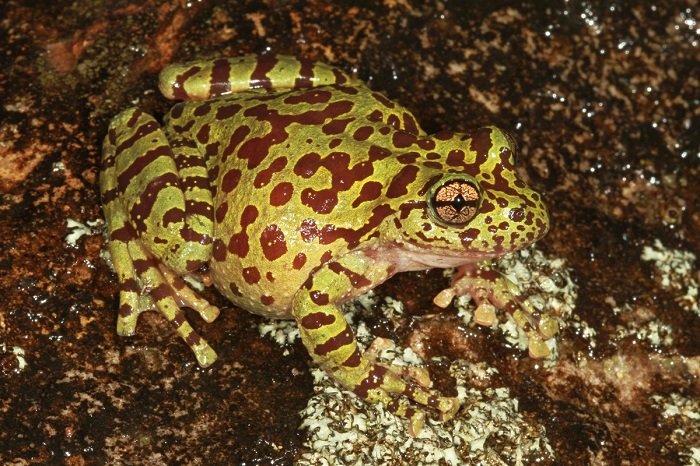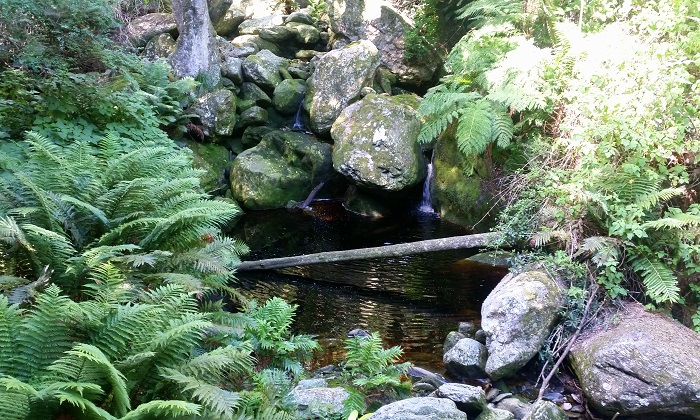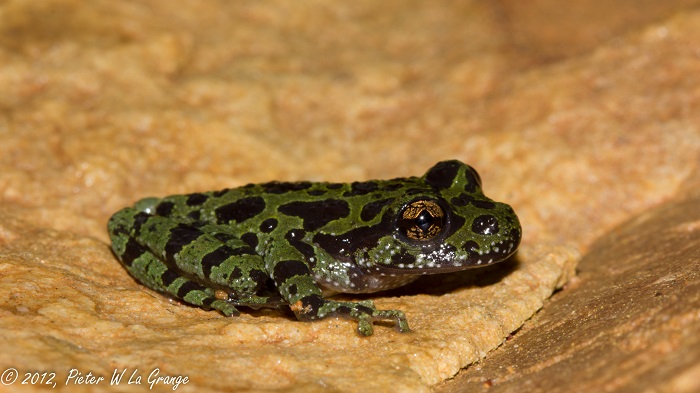Cover photo by Pieter La Grange.
Find the Cape Ghost Frog in the FBIS database (Freshwater Biodiversity Information System) here.
Family Heleophrynidae
Identification

Paarl, Western Cape
Photo by Luke Kemp
The female Cape Ghost Frog attains 56mm in length whilst males are a little smaller, reaching 47mm in length. The dorsal colour varies from yellowish-brown to bright green with reddish-brown blotching.
Habitat
The Cape Ghost Frog is restricted to Mountain Fynbos environments in the winter-rainfall region where annual rainfall is 600–3000 mm (Boycott 1982). It inhabits clear, swift-flowing, perennial mountain streams. The Cape Ghost Frog is often found in wooded or forested ravines and gorges where streams receive direct sunlight at midday.

Marloth Nature Reserve, Western Cape
Photo by Ryan Tippett
Adults have been found under submerged rocks in streams, on wet rock faces, under mats of spongy moss and watergrass, in rock cracks, and in caves (Visser 1990). On one occasion, a frog was found clinging to the wall of the old Du Toit’s Kloof road tunnel (G. McLachlan pers. comm.). During the day adults sometimes sit in clear view at the bottom of pools. The tadpoles are found beneath submerged and partly submerged rocks in streams and rocky pools.

Drakenstein Mountains, Western Cape
Photo by Pieter la Grange
Behaviour
During the winter non-breeding period, juvenile and adult frogs have been found sheltering under rocks a considerable distance (500 m) from the nearest river or stream. It appears that some individuals remain in the vicinity of breeding habitat while others disperse into surrounding habitats for part of the year. In August, in rainy conditions, numerous adult males and females were observed moving across tarred roads in the Franschhoek and Bain’s Kloof mountain passes, in many cases far from the nearest suitable breeding habitat. From these observations it appears that widely dispersed individuals will use wet, cool conditions towards the end of winter to return to their breeding habitat.

Bainskloof Pass, Western Cape
Photo by Felicity Grundlingh
The Cape Ghost Frog breeds in early to mid-summer (October–January) when stream flow is reduced. Most calling takes place during the day, particularly in the late afternoon and at dusk, becoming sporadic after dark (Channing 2001; A. Turner pers. comm.). Males call mostly from rock cracks and crevices adjacent to waterfalls and cascades, but also from rocks on the riverbank or protruding from the stream, usually near small cascades and rapids.
During courtship, a male was observed to move in and out of the water calling rapidly all the while. When under the water, the calls were muffled but still audible from about 3 m away. The female approached in a zig-zag fashion extending her forelimbs to touch the male, who responded by touching the female. Male and female frogs extended their arms and rubbed each other on the dorsal and ventral surfaces of the head and touched each other’s forearms. In this species, the arms and head are covered in asperities. This behaviour has been witnessed on two occasions and it appears that touch may serve as an important recognition factor that leads to amplexus and egg laying. Before amplexus could be observed, the pair moved out of sight under a large boulder (Boycott 1988b; Visser 1990).

Bainskloof Pass, Western Cape
Photo by Felicity Grundlingh
The eggs of the Cape Ghost Frog are large-yolked and yellow with a stiff jelly capsule. They are laid singly and may be scattered over a larger surface area than if they were clumped together. Clutches of 50–208 eggs are laid in exposed positions in small, quiet, shady pools adjacent to the main stream. In such situations there is usually a gentle flow of water into the pool from the main stream (Boycott 1972; Visser 1990). Channing (2001) noted that the eggs may also be laid out of the water in seepage zones, as in the Eastern Ghost Frog H. orientalis.
Tadpoles conceal themselves beneath stones on sandy substrates and, when disturbed, attempt to wriggle into the sand. They are eaten by the common Brown Water Snake Lycodonomorphus rufulus. Metamorphs leave the water during March and April (Boycott 1982).

Hottentots Holland Nature Reserve, Western Cape
Photo by Walter Neser
Status and Conservation
The Cape Ghost Frog is not threatened. The species is widely distributed in the Western Cape mountains where most of its habitat enjoys some degree of protection. It occurs in several private and public protected areas.

Hottentots Holland Nature Reserve, Western Cape
Photo by Eloise Costandius
Distribution
The Cape Ghost Frog is endemic to the Western Cape Province of South Africa, occurring throughout the inland mountain ranges from the Cederberg in the north (3218BB, 3219AA), southward to the Hex River, Du Toit’s Kloof, Hottentots Holland and Klein River mountains (3419AD), and eastward along the Riviersonderend and Langeberg mountains to the vicinity of Ashton and Montagu (3320CC). The recorded altitudinal range is 60–1770 m.

The atlas records are reliable, with the caveat that a number of records are based solely on tadpoles. In the vicinity of Ashton and Montagu, the eastern limits of H. purcelli and the western limits of H. orientalis are yet to be determined.
Further Resources
The use of photographs by Eloise Costandius, Felicity Grundlingh, Luke Kemp, Pieter La Grange, and Walter Neser is acknowledged. Other images by Ryan Tippett.
Cape Ghost Frog Heleophryne purcelli Sclater, 1898
Other Common Names: Purcell’s Ghost Frog (Alt. English); Kaapse Spookpadda (Afrikaans).
Recommended citation format: Boycott, RC; Tippett, RM. (2025). Cape Ghost Frog Heleophryne purcelli. Biodiversity and Development Institute, Cape Town. Available online at https://thebdi.org/2021/12/20/cape-ghost-frog-heleophryne-purcelli/
This species text has been updated and expanded from the text in the
2004 frog atlas: Booysen, RC. (2004). Cape Ghost Frog Heleophryne purcelli. In Minter LR
et al 2004.
References:
Minter, LR; Burger, M; Harrison, JA; Braack, HH; Bishop, PJ; Kloepfer, D. (Editors). (2004). Atlas and Red Data Book of the Frogs of South Africa, Lesotho and Swaziland. Smithsonian Institution, Washington, and Avian Demography
Unit, Cape Town.
Carruthers, V; du Preez, L. (2017). Frogs of southern Africa: A Complete Guide. Struik Nature, Cape Town.
Channing, A. (2001) Amphibians of Central and Southern Africa. Protea Book House, Pretoria
Claus, B; Claus, R. (2002). Common Amphibians and Reptiles of Botswana. Gamsberg Macmillan, Windhoek.

